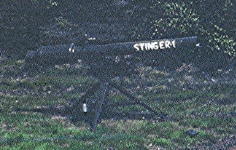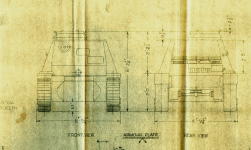

Volume 4, Issue 3
December 30, 2008
Introduction
Welcome to the twelfth issue of "Heavy Metal" -- the newsletter of the
Virginia Museum of Military Vehicles (VMMV). Our mission is our motto -- by working to restore armored fighting vehicles, artillery, small arms, uniforms, and accoutrements of the US military and other countries, we hope to share the legacy of the sacrifice and courage of our fighting men and women with future generations of Americans. Located in Northern Virginia, our collection has grown to over 90 vehicles, starting out with the first US tank, the M 1917 through such legendary US vehicles as the M4A1 and M4A3 Sherman , M3A1 and M5A1 Stuart , M24 Chaffee , M3A1 Half-track , M36 Jackson and M3 Lee along with a few vehicles you might not know existed -- such as a prototype of the Rapid Deployment Force (RDF) tank.
Get to know your VMMV staff & vehicles
In this section we will introduce you to the people and armor of the Virginia Museum of Military Vehicles. We will chat with the VMMV staff, so that you can get to know the people who "keep 'em running" and work so hard behind the scenes. And also provide a behind-the-scenes look into the history of individual vehicles in the VMMV collection. In this, our twelfth newsletter, we chat with Bob Bruggleman, a longtime volunteer at VMMV.
Please tell us a little about your background.
I was born in 1941. My father was in the financial side of the newspaper game. I moved around a lot—St Louis, Missouri, Omaha, Nebraska, Morgantown, West Virginia, and Falls Church, Va. I attended West Virginia University for a year and half and left to enlist in the Army. I have studied military history since I was thirteen years of age.
So, you were in the Army?
I enlisted December 16th, 1959. I arrived at Fort Knox and started basic training on January 2nd, 1960. After basic training, I moved four blocks for armor training. I graduated with honors and shipped for Germany. I was assigned to C Company, 2nd Battalion, 8th Infantry Division at Baumholder, in the then-West Germany. I worked my way from loader to tank commander. I was a proficiency paid gunner.Rumor has it that you can make an M-48 or M-60 tank dance. Is that true?
When I arrived in Germany, I was assigned as the First Sergeants‘ Jeep driver. I was soon assigned to tank C-55, the XO’s tank as loader. After about six months, I volunteered for a new unit being formed in the battalion. I spent the next thirteen months with the Davy Crockett section. The section was dissolved and I returned to C Company and was assigned as gunner on tank C-23. I was given command of C-23 for about six months. I was only a Spec. 4 at the time and most tank commanders were an E-5 sergeant or higher. I took the proficiency test for gunnery and passed. I took C-23 to Grafenwoehr and missed passing the qualification tables by 25 points. I left the army on December 27th, 1963, with the rank of Specialist, Fifth class (E-5).
Wow, so you worked with the Davy Crockett weapons system, that is pretty unusual!!! What was that like?
Our section was directly responsible to the Battalion commander and our ranking NCO, had been an instructor at the Eighth Division’s NCO academy. We learned the curriculum of the NCO academy without the BS and the ins and outs of the Davy Crockett system. After training for about nine months, we took and passed a Technical Proficiency Test. If we had not passed the TPI, both the Battalion commander and our section leader would have been relieved of duty. The Battalion commander knew each of us on a first name basis.
Can you give our readers a feel for what it was like to be in the Armor Corps facing off against the Soviets during the 1960s?
The Eighth Division was a second echelon unit. Our job was to move to the Rhine River and defend it for as long as possible. I never saw any Russians. I did spend many days and nights responding to alerts tho. When the alert was received, we ran to the motor pool and headed out on to the reservation to hide. We would remain there until notified of the all clear or received orders to move to the Rhine.So, even tho you are retired, you still volunteer as a Firefighter?
I spent ten years riding fire trucks and ten years in the administrative side of Engine Company 16, Buckhall Volunteer Fire Department. I was the Treasurer for eight years. I retired from the department but am a supporting member.What is your favorite tank of all time?
I think the Tiger I is my favorite tank (I wonder what it would have felt like to have been the commander of one) and the M-60 a near second.What is your favorite vehicle in the VMMV collection?
I like the M-24 Chaffee and the M-5 Stuart.Does fruit belong on pizza?
I would have to say Yes on pizza.Ketchup or mustard?
Mustard most definitely!From the Files of VMMV......
From the Files of VMMV......
In this section, we will examine historical records and files on armor in World War II from the perspective of the British liaison office to the US War Department. Some of this correspondence discusses the capabilities and performance of US armor, other files are the British view of German armor, reflecting their understanding of the technical capabilities of the panzers they faced. VMMV is proud to be the custodian of these historical treasures and wishes to thank Mr.Peter Upton for donating his father's war time papers.
(Click on drawing to enlarge)
These files represent the actual understanding of the Allies of German armored fighting vehicles and represent a critical link between the myths and propaganda of both sides and the post-war technical exploitation. Some of the data may be incorrect or missing, represent critical intelligence that was unknown to the Allies at the time. You the reader are presented with the data in raw form to allow you to see the ground truth of Allied intelligence.
We will start off this series with the Panzerkampfwagen I or PzKw I. Not the first German tank, that was the AFV 7 of WWI fame, but the first tank of the Wehrmacht. Designed in 1933 as a training vehicle, the PzKw I was never meant to see combat, however, variants of it served up to the Normandy invasion in 1944.
This first document is dated 25 October 1943 and lists in tabular form the armor thickness and angle for the Ausfuhrung (Model) A and Ausf B. Later documents of this type no longer listed the PzKw I, indicating the British believed it had been withdrawn from service.
(Click on drawing to enlarge)
These next three undated scans show several views of the Ausf B.
(Click on drawing to enlarge)
In this unique blueprint, we have a silhouette of the PzKw I showing the relative thickness of its armor and angle.
(Click on drawing to enlarge)
Here we have two scans of the PzKw I Panzerbefehlswagen, or armoured command vehicle. Combat experience taught the Wehrmacht the need for a suitably protected vehicle to allow commanders to keep up with their panzer divisions and they quickly modified some PzKw I’s for this purpose.
(Click on drawing to enlarge)
Last, we have a blueprint silhouette of the PzKw I commanders vehicle showing the relative thickness of its armor and angle.
(Click on drawing to enlarge)
VMMV Acronym
The lexicon of armored vehicles is filling with a bewildering amount of acronyms. And at VMMV we have a few of our own. Here we will have the VMMV word of the day so you may better understand the conversations you might overhear at the museum.Black Oxide: Just like in economics, black oxide is good at VMMV, red oxide is bad. Red Oxide is actually more accurately called ferric oxide but is more commonly known as rust. And rust represents the oxidation of the iron present in the metal of the vehicles, parts and weapons at VMMV. The staff and volunteers of VMMV hate rust because it weakens the metal. But many of our vehicles are old or may have been less than perfectly maintained before finding a home at VMMV and suffer from varying degrees of rust.
In order to stop rust, VMMV may sandblast a part to get rid of surface rust. Or in some cases, the rust can simply be scrubbed or brushed off. But if the rust is deep into the metal, VMMV personnel will treat the red oxide with a chemical that will alter the red oxide into black oxide, which, with proper care, can stop the progression of rust by creating a barrier between the rust and the oxygen in the air. So remember, black oxide good, red oxide bad.
Mike Panchyshyn-Editor















